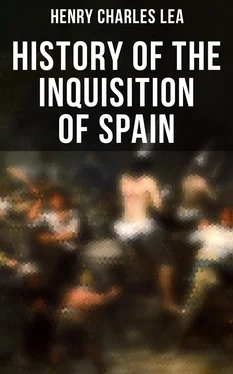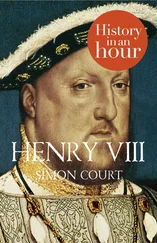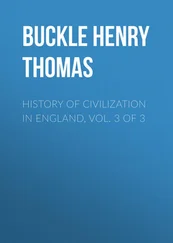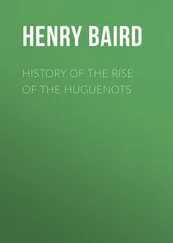THE MUDÉJARES
As for the Mudéjares, the practice of allowing them to remain in the reconquered territories began early. Even in Galicia they were to be found, and in Leon documents of the tenth century contain many Moorish names among those who confirm or witness them.[171] The Fuero of Leon, granted by Alfonso V in 1020, alludes to Moors holding slaves, and the Berber population there is still represented by the Maragatos, to the south-west of Astorga—a race perfectly distinct from the Spaniards, retaining much of their African costume and speaking Castilian imperfectly, although it is their only language.[172] Fernando I (1033–65), who rendered the Kings of Toledo and Seville tributary, and who was besieging Valencia when he died, alternated in his policy towards the inhabitants of his extensive conquests. In the early part of his reign he allowed them to remain; then he adopted depopulation, and finally he returned to his earlier methods.[173] Alfonso VI followed the more liberal system; when he occupied Toledo, in 1085, he granted a capitulation to the inhabitants which secured to them their property and religion, with self-government and the possession of their great mosque.[174] When, during his absence, the Frenchman, Bernard Abbot of Sahagun, newly elected to the archbishopric, in concert with his queen, Constance of Burgundy, suddenly entered the mosque, consecrated it and placed a bell on its highest minaret, Alfonso was greatly angered. He hastened to Toledo, threatening to burn both the queen and the archbishop, and only pardoned them at the intercession of the Moors, who dreaded possible reprisals after his death. His policy, in fact, was to render his rule more attractive to the Moslem population than that of his tributaries, the petty reyes de taifas , who were obliged to oppress their subjects in order to satisfy his exigencies. He even styled himself Emperador de los dos cultos . His tolerant wisdom justified itself, for, after the coming of the Almoravides, in spite of the disastrous defeats of Zalaca and Uclés, he was able to hold his own and even to extend his boundaries, for the native Moors preferred his domination to that of the savage Berbers.[175]
His successors followed his example, but it was not regarded with favor by the Church. During the centuries of mental torpor which preceded the dawn of modern civilization there was little fanaticism. With the opening of the twelfth century various causes awoke the dormant spirit. Crusading enthusiasm brought increased religious ardor and the labors of the schoolmen commenced the reconstruction of theology which was to render the Church dominant over both worlds. The intellectual and spiritual movement brought forth heresies which, by the commencement of the thirteenth century, aroused the Church to the necessity of summoning all its resources to preserve its supremacy. All this made itself felt, not only in Albigensian crusades and the establishment of the Inquisition, but in increased intolerance to Jew and Saracen, in a more fiery antagonism to all who were not included in the pale of Christianity. How this worked was seen, in 1212, when, after the brilliant victory of Las Navas de Tolosa, Alfonso IX advanced to Ubeda, where 70,000 men had collected, and they offered to become Mudéjares and to pay him a million of doblas. The terms were acceptable and he agreed to them, but the clerical chiefs of the crusade, the two archbishops, Rodrigo of Toledo and Arnaud of Narbonne, objected and forced him to withdraw his assent. He offered the besieged to let them depart on the payment of the sum, but they were unable to collect so large an amount on the spot, and they were put to the sword, except those reserved as slaves.[176] In the same spirit Innocent IV, in 1248, ordered Jaime I of Aragon to allow no Saracens to reside in his recently conquered Balearic Isles except as slaves.[177]
THE MUDÉJARES
In spite of the opposition of the Church the policy of the mudéjalato was continued until the work of the Reconquest seemed on the point of completion under San Fernando III. The King of Granada was his vassal, like any other Castilian noble. He subdued the rest of the land, giving the local chiefs advantageous terms and allowing them to assume the title of kings. The Spanish Moors were thus reduced to submission and he was preparing to carry his arms into Africa at the time of his death, in 1252.[178] That Moorish rule, more or less independent, continued in the Peninsula for yet two centuries and a half, is attributable solely to the inveterate turbulence of the Castilian magnates aided by the disorderly ambition of members of the royal family. During this interval successive fragments were added to Christian territory, when internal convulsions allowed opportunities of conquest, and in these the system which had proved so advantageous was followed. Moor and Jew were citizens of the realm, regarded as a desirable class of the population, and entitled to the public peace and security for their property under the same sanctions as the Catholic.[179] They are enumerated with Christians in charters granting special exemptions and privileges to cities, safeguards for fairs and for general trade.[180] Numerous Fueros which have reached us place all races on the same level, and a charter of Alfonso X, in 1272, to the city of Murcia, in its regulations as to the cleansing of irrigating canals, shows that even in petty details such as these there was no distinction recognized between Christian and Moor.[181] The safeguards thrown around them are seen in the charter of 1101, granted to the Mozárabes of Toledo by Alfonso VI, permitting them the use of their ancestral Fuero Juzgo, but penalties under it are only to be one-fifth, as in the Fuero of Castile “except in cases of theft and of the murder of Jews and Moors,” and in the Fuero of Calatayud, granted by Alfonso el Batallador, in 1131, the wergild for a Jew or a Moor is 300 sueldos, the same as for a Christian.[182] Yet the practice as to this was not strictly uniform, and the conquering race naturally sought to establish distinctions which should recognize its superiority. The Fuero of Madrid, in 1202, imposes various disabilities on the Moors.[183] A law of Alfonso X, who throughout his reign showed himself favorable to the subject races, emphatically says that, if a Jew strikes a Christian, he is not to be punished according to the privileges of the Jews, but as much more severely as a Christian is better than a Jew; so if a Christian slays a Jew or a Moor he is to be punished according to the Fuero of the place, and if there is no provision for the case, then he is to suffer death or banishment or other penalty as the king may see fit, but the Moor who slays a Christian is to suffer more severely than a Christian who slays a Moor or a Jew.[184]
In an age of class distinctions this was an inevitable tendency and it is creditable to Spanish tolerance and humanity that its progress was so slow. In the violence of the time there was doubtless much arbitrary oppression, but the Mudéjares knew their rights and had no hesitation in asserting them, nor does there seem to have been a disposition to deny them. Thus, in 1387, those of Bustiella complained to Juan I that the royal tax-collectors were endeavoring to collect from them the Moorish capitation tax, to which they were not subject, having in lieu thereof from ancient times paid to the Lords of Biscay twelve hundred maravedís per annum and being entitled to enjoy all the franchises and liberties of Biscay, whereupon the king issued an order to the assessors to demand from them only the agreed sum and no other taxes, and to guarantee to them all the franchises and liberties, uses and customs of the Lordship of Biscay.[185] Even more suggestive is a celebrated case occurring as late as the reign of Henry IV. In 1455 the chaplains of the Capella de la Cruz of Toledo complained to the king that the tax on all meat slaughtered in the town had been assigned to the chapel for its maintenance, but that the Moors had established their own slaughter-house and refused to pay the tax. Elsewhere than in Spain the matter would have been referred to an ecclesiastical court with a consequent decision in favor of the faith, but here it went to the civil court with the result that, after elaborate argument on both sides, in 1462 the great jurist Alfonso Díaz de Montalvan rendered a decision recognizing that the Moors could not eat meat slaughtered in the Christian fashion, that they were entitled to a slaughter-house of their own, free of tax, but that they must not sell meat to Christians and must pay the tax on all that they might thus have sold.[186] Trivial as is this case, it gives us a clear insight into the independence and self-assertion of the Moorish communities and the readiness of the courts to protect them in their rights.
Читать дальше












